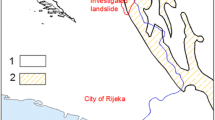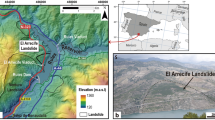Abstract
The Torgiovannetto quarry (Assisi municipality, central Italy) is an example of a site where the natural equilibrium was altered by human activity, causing current slope instability phenomena which threaten two roadways important for the local transportation. The quarry front, having a height of about 140 m, is affected by a 182,000 m3 rockslide developed in intensely fractured limestone and is too large to be stabilized. In 2003 some tension cracks were detected in the vegetated area above the quarry upper sector. From then on, several monitoring campaigns were carried out by means of different instrumentations (topographic total station, extensometers, inclinometers, ground-based interferometric radar, laser scanner and infrared thermal camera), allowing researchers to accurately define the landslide area and volume. The latter’s major displacements are localized in the eastern sector. The deformational field appears to be related to the seasonal rainfall. The landslide hazard associated with the worst case scenario was evaluated in terms of magnitude, intensity and triggering mechanism. For the definition of the possible runout process the DAN 3D code was employed. The simulation results were used in order to design and construct a retaining embankment. Furthermore, in order to preserve both the safety of the personnel involved in its realization and of the roadways users, an early warning system was implemented. The early warning system is based on daily-averaged displacement velocity thresholds. The alarm level is reached if the prediction based on the methods of Saito (1969) and Fukuzono (1985) forecasts an imminent rupture.
Similar content being viewed by others
References
Baroň I, Bečkovský D, Míča L (2014) Application of infrared thermography for mapping open fractures in deep-seated rockslides and unstable cliffs. Landslides 11(1): 15–27. DOI: 10.1007/s10346-012-0367-z.
Bossi G, Frigerio S, Mantovani M, et al. (2013) Hazard assessment of a potential rock avalanche in south Tyrol, Italy: 3D modeling and risk scenarios. Italian Journal of Engineering Geology and Environment 2: 221–228. DOI: 10.4408/IJEGE.2013-06.B-19. DOI: 10.4408/IJEGE.2013-06.B-19.
Del Ventisette C, Intrieri E, Luzi G, et al. (2011) Using ground based radar interferometry during emergency: The case of the A3 motorway (Calabria Region, Italy) threatened by a landslide. Natural Hazards and Earth System Science 11(9): 2483–2495. DOI: 10.5194/nhess-11-2483-2011.
Di Traglia F, Del Ventisette C, Rosi M, et al. (2013) Ground Based InSAR reveals conduit pressurization pulses at Stromboli volcano. Terra Nova 25: 192–198. DOI: 10.1111/ter.12020.
Di Traglia F, Intrieri E, Nolesini T, et al. (2014) The groundbased InSAR monitoring system at Stromboli volcano: linking changes in displacement rate and intensity of persistent volcanic activity. Bulletin of Volcanology 76(786): 1–18. DOI 10.1007/s00445-013-0786-2
Frohlich C, Mettenleiter M (2004) Terrestrial laser scanningnew perspectives in 3D surveying. In: Thies M, Koch B, Spiecker H, et al. (eds), Laser-scanners for forest and landscape assessment, 36. International Archives of Photogrammetry, Remote Sensing and Spatial Information Sciences XXXVI part 8/W2: 7–13.
Fukuzono T (1985) A method to predict the time of slope failure caused by rainfall using the inverse number of velocity of surface displacement. Journal of Japanese Landslide Society 22: 8–13.
Gigli G, Fanti R, Canuti P, et al. (2011) Integration of advanced monitoring and numerical modeling techniques for the complete risk scenario analysis of rockslides: the case of Mt. Beni (Florence, Italy). Engineering Geology 120(1–4): 48–59. DOI: 10.1016/j.enggeo.2011.03.017.
Gigli G, Frodella W, Mugnai F, et al. (2012) Instability mechanisms affecting cultural heritage sites in the Maltese Archipelago. Natural Hazards and Earth System Science 12(6): 1883–1903. DOI: 10.5194/nhess-12-1883-2012
Gigli G, Frodella W, Garfagnoli F, et al. (2013) 3-D geomechanical rock mass characterization for the evaluation of rockslide susceptibility scenarios. Landslides 11: 131–140. DOI: 10.1007/s10346-013-0424-2.
Graziani A, Rotonda T, Tommasi P (2009a) Stability and deformation mode of a rock slide along interbeds reactivated by rainfall. Proceeding of the 1st Italian Workshop on Landslides, Naples, 8th–10th June 2009, 1: 62–71.
Graziani A, Marsella M, Rotonda T, et al. (2009b) Study of a rock slide in a limestone formation with clay interbeds. In: Kulatilake PHSW (ed), Proceedings of the International Conference on Rock Joints and Jointed Rock Masses, Tucson, Arizona, USA 7th–8th January 2009, paper 1038: 1–8.
Hungr O, Morgan GC, Kellerhals R (1984) Quantitative analysis of debris torrent hazards for design of remedial measures. Canadian Geotechnical Journal 21: 663–677. DOI: 10.1139/t84-073).
Hungr O (1995) A model for the runout analysis of rapid flow slides, debries flows and avalanches. Canadian Geotechnical Journal 32: 610–623.
Hungr O (2002) Analytical models for slides and flows. Proceeding International Symposium Landslide Risk Mitigation and Protection of Cultural and Natural Heritage, Kyoto, 21–25 January. pp 559–586.
Intrieri E, Gigli G, Mugnai F, et al. (2012) Design and implementation of a landslide early warning system. Engineering Geology 147–148: 124–136. DOI: 10.1016/j.enggeo.2012.07.017.
Intrieri E, Di Traglia F, Del Ventisette C, et al. (2013a) Flank instability of Stromboli volcano (Aeolian Islands, Southern Italy): Integration of GB-InSAR and geomorphological observations. Geomorphology 201: 60–69. DOI: 10.1016/j.geomorph.2013.06.007.
Intrieri E, Gigli G, Casagli N, et al. (2013b) Brief communication Landslide Early Warning System: Toolbox and general concepts. Natural Hazards and Earth System Science 13(1): 85–90. DOI: 10.5194/nhess-13-85-2013.
McDougall S, Hungr O (2004) A model for the analysis of rapid landslide runout motion across three-dimensional terrain. Canadian Geotechnical Journal 41: 1084–1097. DOI: 10.1139/T04-052.
Rocscience (2004) Swedge Ver. 4.0. User’s manual.
Rose ND, Hungr O (2007) Forecasting potential rock slope failure in open pit mines using the inverse-velocity method. International Journal of Rock Mechanics & Mining Sciences 44: 308–330.
Rudolf H, Leva D, Tarchi D, et al. (1999) A mobile and versatile SAR system. Proceedings of Geoscience and Remote Sensing Symposium, IGARSS 1999, Hamburg, 592–594.
Saito M (1969) Forecasting time of slope failure by tertiary creep. Proceedings of the 7th International Conference on Soil Mechanics and Foundation Engineering, Mexico City, 2: 677–683.
Slob S, Hack HRGK, Turner K (2002) An approach to automate discontinuity measurements of rock faces using laser scanning techniques. In: Dinid da Gama C, Riberia e Sousa L (eds.), Proceedings of ISRM EUROCK 2002, Funchal, Portugal, 25–28 November 2002, Sociedade Portuguesa de Geotecnia, 87–94.
Spampinato L, Calvari S, Oppenheimer C, et al. (2011) Volcano surveillance using infrared cameras. Earth-Science Reviews 106: 63–91. DOI: 10.1016/j.earscirev.2011.01.003.
Tarchi D, Casagli N, Moretti S, et al. (2003) Monitoring landslide displacements by using ground-based radar interferometry: Application to the Ruinon landslide in the Italian Alps. Journal of Geophysical Research 108: 101–114. DOI: 10.1029/2002JB002204.
Teza G, Marcato G, Castelli E, et al. (2012) IRTROCK: a matlab toolbox for contactless recognition of surface and shallow weakness traces of a rock mass by infrared thermography. Computers & Geosciences 45: 109–118. DOI: 10.1016/j.cageo.2011.10.022.
Willenberg H, Eberhardt E, Loew S, et al. (2009) Hazard assessment and runout analysis for an uns rock slope above an industrial site in the Riviera valley, Switzerland. Landslides 6(2): 111–116. DOI: 10.1016/j.enggeo.2005.06.033.
Wu JH, Lin HM, Lee DH, et al. (2005) Integrity assessment of rock mass behind the shotcreted slope using thermography. Engineering Geology 80: 164–173. DOI: 10.1016/j.enggeo.2005.04.005.
Zischg A, Fuchs S, Keiler M, et al. (2005) Modelling the system behaviour of wet snow avalanches using an expert system approach for risk management on high alpine traffic roads. Natural Hazards and Earth System Science 5(6): 821–832. DOI: 10.5194/nhess-5-821-2005.
Author information
Authors and Affiliations
Corresponding author
Rights and permissions
About this article
Cite this article
Gigli, G., Intrieri, E., Lombardi, L. et al. Event scenario analysis for the design of rockslide countermeasures. J. Mt. Sci. 11, 1521–1530 (2014). https://doi.org/10.1007/s11629-014-3164-4
Received:
Accepted:
Published:
Issue Date:
DOI: https://doi.org/10.1007/s11629-014-3164-4




